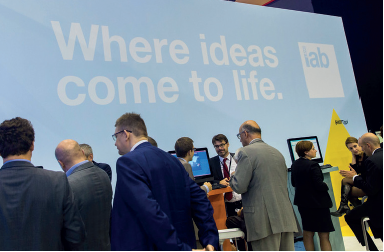With distributed ledger technology a major subject of discussion at Sibos in Singapore, this year’s event provided an opportunity to demonstrate practical advances in preparing the new technology for deployment in financial services.

The SWIFTLab at Sibos 2016
Over the past two years, both distributed ledger technologies (DLTs) and smart contracts (SCs) have generated huge interest amongst financial institutions and technology providers. There is a growing consensus that they are likely to transform automation within the financial services industry. “The promise of DLT is the synchronisation of financial data between multiple organisations, whilst SCs can further provide self-executing efficiencies on the ledger,” says Stephen Lindsay, head of standards, SWIFT.
To enable their application on an industrial scale, however, a level of standardisation is required. In a paper released by the cooperative on the eve of Sibos, SWIFT addressed the application of business standards to these technologies. It acknowledged that while the relative immaturity of DLT will delay full-scale standardisation, it is still possible to outline the direction standardisation should take.
The paper examines the role of standards from two angles: the necessary preconditions for standardisation of DLT/ SC, and the possibility of repurposing some of today’s existing standards. To avoid the fragmentation of global standards, SWIFT identifies a clear opportunity for the financial community to coordinate efforts over common messaging and data standards.
Damien Vanderveken, head of R&D and SWIFTLabs, SWIFT, points out that SWIFT itself is engaged in a set of R&D activities related to DLT with the aim of progressing the technology to a point where it can be practically applied within the community. “Some of the initiatives we are involved in, like the Hyperledger project, are consortia, while others we are doing ourselves,” he explains.
In the SWIFTLab
Sibos provided an opportunity to show the progress made to date. A presentation in the SWIFTLab at Sibos demonstrated a working model of DLT in action. “We’ve been experimenting with DLT as we believe you can’t really understand it until you’ve tried it,” said Lindsay, introducing a live proof-of-concept application, covering the lifecycle of a fixed rate bond. “We are very interested in how we can reuse ISO 20022 in particular,” said Lindsay.
Deployed in the Amazon Cloud, the application showed nodes in different locations representing the various participants in a bond transaction, including issuers, intermediaries and investors. It illustrated both the process of buying and selling such a bond as well as the payment of a coupon, using elements of ISO 20022.
With each step of the transaction, the ledger is updated at all nodes, ensuring a comprehensive and immutable record of activity in the life of the bond. Lindsay stressed, however, that, “Not everyone can see everything.” Appropriate cryptography ensures that investors, for example, can only see their own transactions.
Work to optimise the use of existing standards in this new operational domain will continue at SWIFT, says Vanderveken. “We should avoid reinventing the wheel,” he says. “There is clear value in re-using reference data standards and business content from messaging standards, most obviously ISO 20022, which has the widest industry coverage and an adaptable technical architecture.” (News source:SWIFT)


